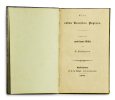KIERKEGAARD, SØREN.
Af en endnu Levendes Papirer. Udgivet mod hans Villie af S. Kjerkegaard. - [KIERKEGAARD'S OWN COPY, SPLENDIDLY BOUND FOR HIMSELF]
Kjøbenhavn, C. A. Reitzel, 1838. 8vo. X, (2), 79 pp. Magnificently bound for Kierkegaard himself in a patterned silver cloth binding with green leaves. All edges gilt. Printed on vellum-paper. The copy is noticeably larger than other copies of the book. Old owner’s inscription to inside of front board and small ex libris (Theodor Find) to the green front free end-paper.
Reference : 62104
First edition, Kierkegaard’s own copy (from his own book collection, sold after his death), splendidly bound for himself, of his first work, which sews the seeds of his future career and initiates his philosophical production. It is in this famous review of Hans Christian Andersen as an author of novels, with a particular focus on his Only a Fiddler that Kierkegaard – the then 25 year-old theology student known only in a small academic circle, for his wit and sharp intelligence – puts forth his devastating criticism of Hans Christian Andersen – then 33 years old and already widely famous, Denmark’s other national hero and world-famous fairy tale-author. Even though the book is written as a polemic review, we already here witness Kierkegaard’s introduction of his emphasis on authentic individual existence which will continue throughout his entire production" as thus, From the Papers of one Still Living serves as a highly important introduction to Kierkegaard’s philosophical-ethical production. Kierkegaard points out that Hans Christian Andersen has not yet found himself and therefore cannot be a good author. This emphasis on authenticity and on the necessary first stage of the epic becomes an introduction to Kierkegaard’s famous theory of stages that he develops in his later works. He rejects the notion that environment is decisive in determining the fate of genius – the genius is a shaping subject, not a passive one formed by circumstances. Not one that needs to be nurtured and sheltered in order not to perish. The work was originally meant to be published as an article in the literary periodical Perseus, of which Johan Ludvig Heiberg was the editor. But the article grew too extensive, and the intended columns in the periodical were given to H.L. Martensen instead. Martensen’s article took up 70 pages and was about the idea of Faust, which vexed Kierkegaard, who had wanted to write about that subject himself. A contemporary note to the front free end-paper of the present copy states that it belonged to Kierkegaard himself and that it was bought at the auction of his books. The auction-protocol lists two copies of the work, both elaborately bound and with gilt edges (2957-2057a). Only a few months after Kierkegaard died (11th of November 1855), at the beginning of April 1856, his books were put up for sale. The sale was an event which created stir among scholars all over Denmark, and the event drew large crowds. Everyone wanted a piece of the recently deceased legend, and bidding was lively. The average price for the single items was nearly a rix-dollar a very high price for that time. As the old Herman Lynge wrote in a letter on the 22nd of May (The Royal Library, Recent Letters, D.), to the famous collector F.S. Bang, “At the sale of Dr. Søren Kierkegaard’s books everything went at very high prices, especially his own works, which brought 2 or 3 times the published prices”.” (Rohde Auction Catalogue, p. LVIJ). Many authors, philosophers, and scholars were present in the auction room, which was completely full, as was the Royal Library, who bought ca 80 lots. “Many of the books, not only his own, were paid for with much higher prices than in the book shops” (In Morgenposten no. 99, 30. April 1856, written by “P.”, translated from Danish). ""Some books were bought by libraries where they still are today, others were bought by private people, who sometimes wrote their names in the front of the books and thus, indirectly, stated that they came from Kierkegaard’s book collection… The edition (of the auction catalogue, 1967) registers all books from Kierkegaard’s book collection that it has hitherto been possible to identify – either in public or in private ownership… All in all, nearly a couple of hundred volumes – i.e. ca. 10 % – of the Kierkegaardian book collection is said to be rediscovered…"" (Rohde). Thus, today, books from Kierkegaard’s library are of the utmost scarcity. Only very few are still possible to acquire, and they hardly ever appear on the market. Himmelstrup 6 The present copy is no. 3 in Girsel's ""Kierkegaard"" (The Catalogue) which can be found here.
Bookseller's contact details
Herman H. J. Lynge & Son
William Schneider
Silkegade 11
1113 Copenhagen
Denmark
+45 33 155 335
Payment mode
Sale conditions
All items may be returned for a full refund for any reason within 14 days of receipt.
 Write to the booksellers
Write to the booksellers


